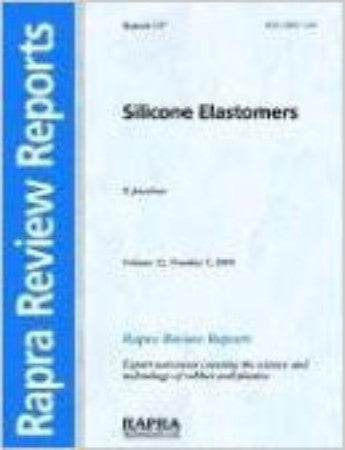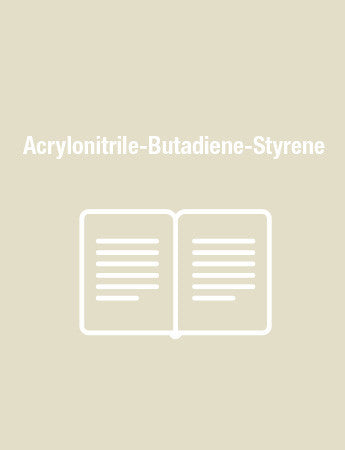Silicone Elastomers
Silicone elastomers are important materials for many application areas such as automotive, electric and electronics, domestic appliances and medical. They are increasingly being used to substitute for organic rubbers, because of their advantageous properties.
This is a very comprehensive review of the state-of-the-art in silicone elastomers. It deals with the advantages of using silicone rubbers, such as high temperature and chemical resistance, pigmentability and transparency, combined with good electrical properties.
It describes processing by extrusion, injection moulding and calendering, and the use of silicones inflexible and rigid mould making. The key issues concerning the processing of silicones are addressed here.
The key material types and the nomenclature used to describe silicones are explained. Room temperature vulcanised (RTV), high temperature vulcanised (HTV) and liquid silicone rubbers (LSR) are all discussed.
Speciality silicones are continually being developed to meet specific application requirements, for example, standard silicone is a good electrical insulator and is used in cable coverings, however, conductive silicones are now available. These new grades of silicones are described and compared to standard grades for key performance issues.
This review is packed with details on specific silicone materials, containing over 50 tables of information together with useful graphs. It is much longer than the usual reviews in this series.
The review is accompanied by around 400 abstracts from the Rapra Abstracts database, to facilitate further reading on this subject.
This is a very comprehensive review of the state-of-the-art in silicone elastomers. It deals with the advantages of using silicone rubbers, such as high temperature and chemical resistance, pigmentability and transparency, combined with good electrical properties.
It describes processing by extrusion, injection moulding and calendering, and the use of silicones inflexible and rigid mould making. The key issues concerning the processing of silicones are addressed here.
The key material types and the nomenclature used to describe silicones are explained. Room temperature vulcanised (RTV), high temperature vulcanised (HTV) and liquid silicone rubbers (LSR) are all discussed.
Speciality silicones are continually being developed to meet specific application requirements, for example, standard silicone is a good electrical insulator and is used in cable coverings, however, conductive silicones are now available. These new grades of silicones are described and compared to standard grades for key performance issues.
This review is packed with details on specific silicone materials, containing over 50 tables of information together with useful graphs. It is much longer than the usual reviews in this series.
The review is accompanied by around 400 abstracts from the Rapra Abstracts database, to facilitate further reading on this subject.
1. Introduction
1.1 Nomenclature
2. Silicone Elastomers Market
3. Applications for Silicone Elastomers
3.1 Automotive
3.2 Healthcare and Medical
3.3 Wire and Cable
3.4 Sanitary, Household, and Leisure
3.5 Transmission and Distribution
3.6 Electronics
3.7 Mould Making
3.8 Food Sector
3.9 Other
4. Composition and Function of Silicone Elastomers
4.1 Introduction and Classifications
4.2 Properties of Silicone Elastomers
4.3 Chemistry and Curing Mechanisms of Silicone Elastomers
5. RTV - Room Temperature Vulcanising Silicone Elastomers
5.1 General
5.2 Condensation Curing RTVs
5.3 RTV-1 for CIPG and FIPG
5.4 RTV-1 for Baking Tray Coatings
5.5 Adhesive RTV-1 Materials
5.6 Condensation Curing RTV-2 Systems
5.7 Mould Making Condensation Curing RTV-2 Materials
5.8 Condensation Curing RTV-2 Compounds for Encapsulation
5.9 Adhesives and Sealants Based on Condensation Curing RTV-2 Compounds
5.10 Addition Curing RTV-2 Systems
5.11 Silicone Gels
5.12 Addition Curing Systems for Mould Making
5.13 Addition Cured RTV-2 Systems for Encapsulation
5.14 Addition Cured RTV-2 Adhesives and Sealants
5.15 Addition Cured RTV-2 Sponge for Compressible Gaskets
6. Liquid Silicone Rubber
6.1 General
6.2 Curing Mechanism of Liquid Silicone Rubbers
6.3 Standard Liquid Silicone Rubbers
6.4 Speciality LRs
6.5 Pigment Pastes
7. Solid Silicone Rubber
7.1 General
7.2 Curing Mechanisms of Solid Silicone Rubbers
7.3 Standard Solid Silicone Rubbers
7.4 Speciality HTV (all peroxide)
7.5 Addition Cured HTV
8. Processing Silicone Elastomers
8.1 RTV-1 Systems
8.2 RTV-2 Systems
8.3 LR and HTV
1.1 Nomenclature
2. Silicone Elastomers Market
3. Applications for Silicone Elastomers
3.1 Automotive
3.2 Healthcare and Medical
3.3 Wire and Cable
3.4 Sanitary, Household, and Leisure
3.5 Transmission and Distribution
3.6 Electronics
3.7 Mould Making
3.8 Food Sector
3.9 Other
4. Composition and Function of Silicone Elastomers
4.1 Introduction and Classifications
4.2 Properties of Silicone Elastomers
4.3 Chemistry and Curing Mechanisms of Silicone Elastomers
5. RTV - Room Temperature Vulcanising Silicone Elastomers
5.1 General
5.2 Condensation Curing RTVs
5.3 RTV-1 for CIPG and FIPG
5.4 RTV-1 for Baking Tray Coatings
5.5 Adhesive RTV-1 Materials
5.6 Condensation Curing RTV-2 Systems
5.7 Mould Making Condensation Curing RTV-2 Materials
5.8 Condensation Curing RTV-2 Compounds for Encapsulation
5.9 Adhesives and Sealants Based on Condensation Curing RTV-2 Compounds
5.10 Addition Curing RTV-2 Systems
5.11 Silicone Gels
5.12 Addition Curing Systems for Mould Making
5.13 Addition Cured RTV-2 Systems for Encapsulation
5.14 Addition Cured RTV-2 Adhesives and Sealants
5.15 Addition Cured RTV-2 Sponge for Compressible Gaskets
6. Liquid Silicone Rubber
6.1 General
6.2 Curing Mechanism of Liquid Silicone Rubbers
6.3 Standard Liquid Silicone Rubbers
6.4 Speciality LRs
6.5 Pigment Pastes
7. Solid Silicone Rubber
7.1 General
7.2 Curing Mechanisms of Solid Silicone Rubbers
7.3 Standard Solid Silicone Rubbers
7.4 Speciality HTV (all peroxide)
7.5 Addition Cured HTV
8. Processing Silicone Elastomers
8.1 RTV-1 Systems
8.2 RTV-2 Systems
8.3 LR and HTV
Dr. Jerschow is a leading scientist in the field of silicone elastomers having written papers on processing, properties and applications and also on bonding. He works for Wacker-Chemie GmbH, a leading silicone elastomer manufacturer, hence examples in the text are drawn from the Wacker-Chemie repertoire of material grades.




